Novel Potential Probiotics from Chinese Baijiu Fermentation Grains: Dual Action of Lactiplantibacillus plantarum LTJ1/LTJ48 in Uric Acid Reduction and Gut Microbiota Restoration for Hyperuricemia Therapy in Mice
Highlights
- Dual-Action Probiotics: L. plantarum strains LTJ1 and LTJ48, derived from Baijiu grains, degrade purines, lower uric acid in cells/mice, and restore gut flora.
- Multi-Target Therapy: These strains suppress ADA, inhibit URAT1/GLUT9, and enhance ABCG2, offering safer hyperuricemia treatment.
- Microbiome Regulation: LTJ1 and LTJ48 enrich beneficial bacteria and reduce harmful taxa, improving gut health in HUA mice.
Abstract
1. Introduction
2. Materials and Methods
2.1. In Vitro Screening of Lactiplantibacillus with High Purine and Nucleoside Degradation Capability
2.2. Strain Identification
2.3. Growth Kinetics Determination
2.4. Induction of HUA Cell Model
2.5. Quantitative UA Analysis
2.6. Animal Experiment Design
2.7. RT-qPCR Analysis
2.8. DNA Extraction and 16S rRNA Gene Amplification
2.9. Statistical Analysis
3. Results
3.1. Solation and Characterization of Nucleoside and Purine-Degrading L. plantarum LTJ1 and LTJ48
3.2. Molecular Identification and Growth Characterization of L. plantarum LTJ1 and LTJ48
3.3. L. plantarum LTJ1 and LTJ48 Suppress UA Biosynthesis in HUA HepG2 Cells
3.4. L. plantarum LTJ1 and LTJ48 Ameliorate HUA in Mice Through ADA Suppression
3.5. L. plantarum LTJ1 and LTJ48 Modulate UA Transporters in the Liver and Kidney Tissue of HUA Mice
3.6. L. plantarum LTJ1 and LTJ48 Restore Gut Microbiota Homeostasis in HUA Mice
4. Discussion
5. Conclusions
Author Contributions
Funding
Institutional Review Board Statement
Informed Consent Statement
Data Availability Statement
Conflicts of Interest
Abbreviations
| HUA | Hyperuricemia |
| XOD | Xanthine oxidase |
| URAT1 | Urate transporter 1 |
| ADA | Adenosine deaminase |
| CRE | Serum creatinine |
| BUN | Blood urea nitrogen |
| AST | Aspartate aminotransferase |
| ALT | Alanine aminotransferase |
| ABCG2 | ATP-binding cassette sub-family G member 2 |
| GLUT9 | Glucose transporter 9 |
References
- Pang, S.; Jiang, Q.; Sun, P.; Li, Y.; Zhu, Y.; Liu, J.; Ye, X.; Chen, T.; Zhao, F.; Yang, W. Hyperuricemia prevalence and its association with metabolic disorders: A multicenter retrospective real-world study in China. Ann. Transl. Med. 2021, 9, 1550. [Google Scholar] [CrossRef] [PubMed]
- Yanai, H.; Adachi, H.; Hakoshima, M.; Iida, S.; Katsuyama, H. A possible therapeutic application of the selective inhibitor of Urate Transporter 1, Dotinurad, for metabolic syndrome, chronic kidney Disease, and Cardiovascular Disease. Cells 2024, 13, 450. [Google Scholar] [CrossRef] [PubMed]
- Wei, X.; Zhang, M.; Huang, S.; Lan, X.; Zheng, J.; Luo, H.; He, Y.; Lei, W. Hyperuricemia: A key contributor to endothelial dysfunction in cardiovascular diseases. FASEB J. 2023, 37, e23012. [Google Scholar] [CrossRef]
- Du, L.; Zong, Y.; Li, H.; Wang, Q.; Xie, L.; Yang, B.; Pang, Y.; Zhang, C.; Zhong, Z.; Gao, J. Hyperuricemia and its related diseases: Mechanisms and advances in therapy. Signal Transduct. Target. Ther. 2024, 9, 212. [Google Scholar] [CrossRef]
- Vareldzis, R.; Perez, A.; Reisin, E. Hyperuricemia: An intriguing connection to metabolic syndrome, diabetes, kidney disease, and hypertension. Curr. Hypertens. Rep. 2024, 26, 237–245. [Google Scholar] [CrossRef] [PubMed]
- Kuwabara, M.; Ae, R.; Kosami, K.; Kanbay, M.; Andres-Hernando, A.; Hisatome, I.; Lanaspa, M.A. Current updates and future perspectives in uric acid research 2024. Hypertens. Res. 2024, 48, 1–7. [Google Scholar] [CrossRef]
- Yang, S.; Liu, H.; Fang, X.-M.; Yan, F.; Zhang, Y. Signaling pathways in uric acid homeostasis and gout: From pathogenesis to therapeutic interventions. Int. Immunopharmacol. 2024, 132, 111932. [Google Scholar] [CrossRef]
- Wang, Q.; Liang, J.; Zou, Q.; Wang, W.; Yan, G.; Guo, R.; Yuan, T.; Wang, Y.; Liu, X.; Liu, Z. Tryptophan Metabolism-Regulating Probiotics Alleviate Hyperuricemia by Protecting the Gut Barrier Integrity and Enhancing Colonic Uric Acid Excretion. J. Agric. Food. Chem. 2024, 72, 26746–26761. [Google Scholar] [CrossRef]
- Zhang, W. Hyperuricemia: Current State and Prospects. Explor. Res. Hypothesis. Med. 2025, 10, 49–55. [Google Scholar] [CrossRef]
- Al-Worafi, Y.M. Gout and Hyperuricemia Management in Developing Countries. In Handbook of Medical and Health Sciences in Developing Countries: Education, Practice, and Research; Springer: Berlin/Heidelberg, Germany, 2024; pp. 1–42. [Google Scholar]
- Ullah, Z.; Yue, P.; Mao, G.; Zhang, M.; Liu, P.; Wu, X.; Zhao, T.; Yang, L. A comprehensive review on recent xanthine oxidase inhibitors of dietary based bioactive substances for the treatment of hyperuricemia and gout: Molecular mechanisms and perspective. Int. J. Biol. Macromol. 2024, 278, 134832. [Google Scholar] [CrossRef]
- Guo, W.; Wei, M.; Li, Y.; Xu, J.; Zang, J.; Chen, Y.; Chen, L. Mechanisms of urate transport and uricosuric drugs inhibition in human URAT1. Nat. Commun. 2025, 16, 1512. [Google Scholar] [CrossRef] [PubMed]
- Wang, K.; Wang, Y. Anti-hyperuricemia bioactive peptides: A review on obtaining, activity, and mechanism of action. Food Funct. 2024, 15, 5714–5736. [Google Scholar]
- Hung, S.-I.; Mockenhaupt, M.; Blumenthal, K.G.; Abe, R.; Ueta, M.; Ingen-Housz-Oro, S.; Phillips, E.J.; Chung, W.-H. Severe cutaneous adverse reactions. Nat. Rev. Dis. Primers 2024, 10, 30. [Google Scholar] [CrossRef] [PubMed]
- Ghossan, R.; Tabesh, O.A.; Fayad, F.; Richette, P.; Bardin, T. Cardiovascular Safety of Febuxostat in Patients with Gout or Hyperuricemia: A Systematic Review of Randomized Controlled Trials. JCR J. Clin. Rheumatol. 2024, 30, e46–e53. [Google Scholar] [CrossRef]
- Li, G.; Hu, Y.; Zhao, H.; Peng, Z.; Shang, X.; Zhang, J.; Xie, K.; Li, M.; Zhou, X.; Zhou, Q. Slow Metabolism–Driven Amplification of Hepatic PPARγ Agonism Mediates Benzbromarone-Induced Obesity-Specific Liver Injury. Adv. Sci. 2025, 12, 2409126. [Google Scholar] [CrossRef]
- Kaufmann, D.; Chaiyakunapruk, N.; Schlesinger, N. Optimizing Gout Treatment: A Comprehensive Review of Current and Emerging Uricosurics. Jt. Bone Spine 2024, 92, 105826. [Google Scholar] [CrossRef]
- Soraci, L.; Cherubini, A.; Paoletti, L.; Filippelli, G.; Luciani, F.; Laganà, P.; Gambuzza, M.E.; Filicetti, E.; Corsonello, A.; Lattanzio, F. Safety and tolerability of antimicrobial agents in the older patient. Drugs Aging 2023, 40, 499–526. [Google Scholar] [CrossRef]
- Lv, Q.; Zhou, J.; Wang, C.; Yang, X.; Han, Y.; Zhou, Q.; Yao, R.; Sui, A. A dynamics association study of gut barrier and microbiota in hyperuricemia. Front. Microbiol. 2023, 14, 1287468. [Google Scholar] [CrossRef]
- Sun, X.; Wen, J.; Guan, B.; Li, J.; Luo, J.; Li, J.; Wei, M.; Qiu, H. Folic acid and zinc improve hyperuricemia by altering the gut microbiota of rats with high-purine diet-induced hyperuricemia. Front. Microbiol. 2022, 13, 907952. [Google Scholar] [CrossRef]
- Wang, Z.; Li, Y.; Liao, W.; Huang, J.; Liu, Y.; Li, Z.; Tang, J. Gut microbiota remodeling: A promising therapeutic strategy to confront hyperuricemia and gout. Front. Cell. Infect. Microbiol. 2022, 12, 935723. [Google Scholar] [CrossRef]
- Sun, L.; Ni, C.; Zhao, J.; Wang, G.; Chen, W. Probiotics, bioactive compounds and dietary patterns for the effective management of hyperuricemia: A review. Crit. Rev. Food Sci. 2024, 64, 2016–2031. [Google Scholar] [CrossRef] [PubMed]
- Ren, L.; Wang, S.; Liu, S.; Prasanthi, H.A.C.; Li, Y.; Cao, J.; Zhong, F.; Guo, L.; Lu, F.; Luo, X. Postbiotic of Pediococcus acidilactici GQ01, a Novel Probiotic Strain Isolated from Natural Fermented Wolfberry, Attenuates Hyperuricaemia in Mice through Modulating Uric Acid Metabolism and Gut Microbiota. Foods 2024, 13, 923. [Google Scholar] [CrossRef]
- Ro, K.-S.; Zhao, L.; Hu, Y.; Ge, M.; Du, L.; Xie, J. Anti-hyperuricemic properties and mechanism of Lactiplantibacillus plantarum X7023. Process. Biochem. 2024, 136, 26–37. [Google Scholar] [CrossRef]
- Zou, Y.; Ro, K.-S.; Jiang, C.; Yin, D.; Zhao, L.; Zhang, D.; Du, L.; Xie, J. The anti-hyperuricemic and gut microbiota regulatory effects of a novel purine assimilatory strain, Lactiplantibacillus plantarum X7022. Eur. J. Nutr. 2024, 63, 697–711. [Google Scholar] [CrossRef] [PubMed]
- Wang, J.; Chen, Y.; Zhong, H.; Chen, F.; Regenstein, J.; Hu, X.; Cai, L.; Feng, F. The gut microbiota as a target to control hyperuricemia pathogenesis: Potential mechanisms and therapeutic strategies. Crit. Rev. Food Sci. 2022, 62, 3979–3989. [Google Scholar] [CrossRef]
- Zhao, H.; Lu, Z.; Lu, Y. The potential of probiotics in the amelioration of hyperuricemia. Food Funct. 2022, 13, 2394–2414. [Google Scholar] [CrossRef]
- Xu, J.; Tu, M.; Fan, X.; Guo, Y.; Zhang, T.; Zeng, X.; Cai, Z.; Wu, Z.; Pan, D. A novel strain of Levilactobacillus brevis PDD-5 isolated from salty vegetables has beneficial effects on hyperuricemia through anti-inflammation and improvement of kidney damage. Food Sci. Hum. Wellness 2024, 13, 898–908. [Google Scholar] [CrossRef]
- Kuo, Y.-W.; Hsieh, S.-H.; Chen, J.-F.; Liu, C.-R.; Chen, C.-W.; Huang, Y.-F.; Ho, H.-H. Lactobacillus reuteri TSR332 and Lactobacillus fermentum TSF331 stabilize serum uric acid levels and prevent hyperuricemia in rats. PeerJ 2021, 9, e11209. [Google Scholar] [CrossRef]
- Wu, Y.; Ye, Z.; Feng, P.; Li, R.; Chen, X.; Tian, X.; Han, R.; Kakade, A.; Liu, P.; Li, X. Limosilactobacillus fermentum JL-3 isolated from “Jiangshui” ameliorates hyperuricemia by degrading uric acid. Gut Microbes 2021, 13, 1897211. [Google Scholar] [CrossRef]
- Wu, J.; Aga, L.; Tang, L.; Li, H.; Wang, N.; Yang, L.; Zhang, N.; Wang, X.; Wang, X. Lacticaseibacillus paracasei JS-3 Isolated from “Jiangshui” Ameliorates Hyperuricemia by Regulating Gut Microbiota and iTS Metabolism. Foods 2024, 13, 1371. [Google Scholar] [CrossRef]
- Zhao, X.; Cai, P.; Xiong, S.; Wei, B.; Du, T.; Huang, T.; Yu, Q.; Xie, M.; Xiong, T. Lacticaseibacillus rhamnosus NCUH061012 alleviates hyperuricemia via modulating gut microbiota and intestinal metabolites in mice. Food Biosci. 2024, 58, 103699. [Google Scholar] [CrossRef]
- Zhu, W.; Bi, S.; Fang, Z.; Iddrisu, L.; Deng, Q.; Sun, L.; Gooneratne, R. Priestia megaterium ASC-1 Isolated from Pickled Cabbage Ameliorates Hyperuricemia by Degrading Uric Acid in Rats. Microorganisms 2024, 12, 832. [Google Scholar] [CrossRef] [PubMed]
- Liang, Y.; Zeng, T.; Tian, J.; Yan, J.; Lan, Z.; Chen, J.; Xin, X.; Lei, B.; Cai, Z. Long-term environmental cadmium exposure induced serum metabolic changes related to renal and liver dysfunctions in a female cohort from Southwest China. Sci. Total Environ. 2021, 798, 149379. [Google Scholar] [CrossRef]
- Shen, S.; Yan, X.; Xu, B. The blood urea nitrogen/creatinine (BUN/cre) ratio was U-shaped associated with all-cause mortality in general population. Renal Failure 2022, 44, 184–190. [Google Scholar] [CrossRef]
- Kalas, M.A.; Chavez, L.; Leon, M.; Taweesedt, P.T.; Surani, S. Abnormal liver enzymes: A review for clinicians. World. J. Hepatol. 2021, 13, 1688. [Google Scholar] [CrossRef]
- Nian, Y.-L.; You, C.-G. Susceptibility genes of hyperuricemia and gout. Hereditas 2022, 159, 30. [Google Scholar] [CrossRef]
- Song, Y.; March, J. Hyperuricemia and the small intestine: Transport mechanisms and co-morbidities. Biotechnol. Notes. 2022, 3, 32–37. [Google Scholar] [CrossRef] [PubMed]
- Zhang, M.-Q.; Sun, K.-X.; Guo, X.; Chen, Y.-Y.; Feng, C.-Y.; Chen, J.-S.; Barreira, J.C.; Prieto, M.A.; Sun, J.-Y.; Zhang, J.-D. The antihyperuricemia activity of Astragali Radix through regulating the expression of uric acid transporters via PI3K/Akt signalling pathway. J. Ethnopharmacol. 2023, 317, 116770. [Google Scholar] [CrossRef]
- Liu, Y.; Han, Y.; Liu, Y.; Huang, C.; Feng, W.; Cui, H.; Li, M. Xanthoceras sorbifolium leaves alleviate hyperuricemic nephropathy by inhibiting the PI3K/AKT signaling pathway to regulate uric acid transport. J. Ethnopharmacol. 2024, 327, 117946. [Google Scholar] [CrossRef]
- Zhao, S.; Feng, P.; Hu, X.; Cao, W.; Liu, P.; Han, H.; Jin, W.; Li, X. Probiotic Limosilactobacillus fermentum GR-3 ameliorates human hyperuricemia via degrading and promoting excretion of uric acid. Iscience 2022, 25, 105198. [Google Scholar] [CrossRef]
- Li, R.; Yang, P.; Liu, B.; Ye, Z.; Zhang, P.; Li, M.; Gong, Y.; Huang, Y.; Yang, L.; Li, M. Lycium barbarum polysaccharide remodels colon inflammatory microenvironment and improves gut health. Heliyon 2024, 10, e30594. [Google Scholar] [CrossRef] [PubMed]
- Dang, K.; Zhang, N.; Gao, H.; Wang, G.; Liang, H.; Xue, M. Influence of intestinal microecology in the development of gout or hyperuricemia and the potential therapeutic targets. Int. J. Rheum. Dis. 2023, 26, 1911–1922. [Google Scholar] [CrossRef] [PubMed]
- Wu, C.; Zhao, Y.; Zhang, Y.; Yang, Y.; Su, W.; Yang, Y.; Sun, L.; Zhang, F.; Yu, J.; Wang, Y. Gut microbiota specifically mediates the anti-hypercholesterolemic effect of berberine (BBR) and facilitates to predict BBR’s cholesterol-decreasing efficacy in patients. J. Adv. Res. 2022, 37, 197–208. [Google Scholar] [CrossRef] [PubMed]
- Zhang, H.; Lu, Y.; Zhang, Y.; Dong, J.; Jiang, S.; Tang, Y. DHA-enriched phosphatidylserine ameliorates cyclophosphamide-induced liver injury via regulating the gut-liver axis. Int. Immunopharmacol. 2024, 140, 112895. [Google Scholar] [CrossRef]
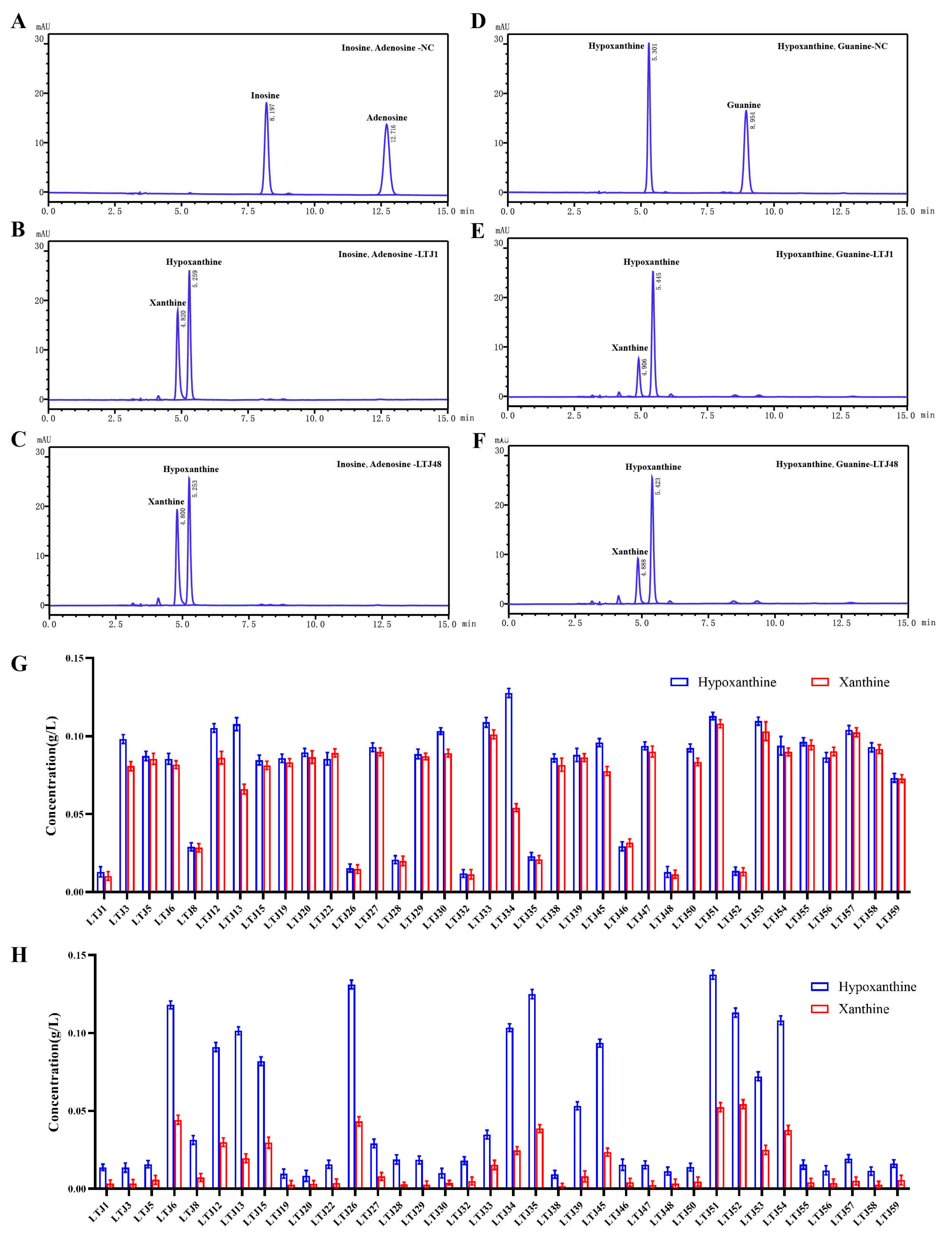
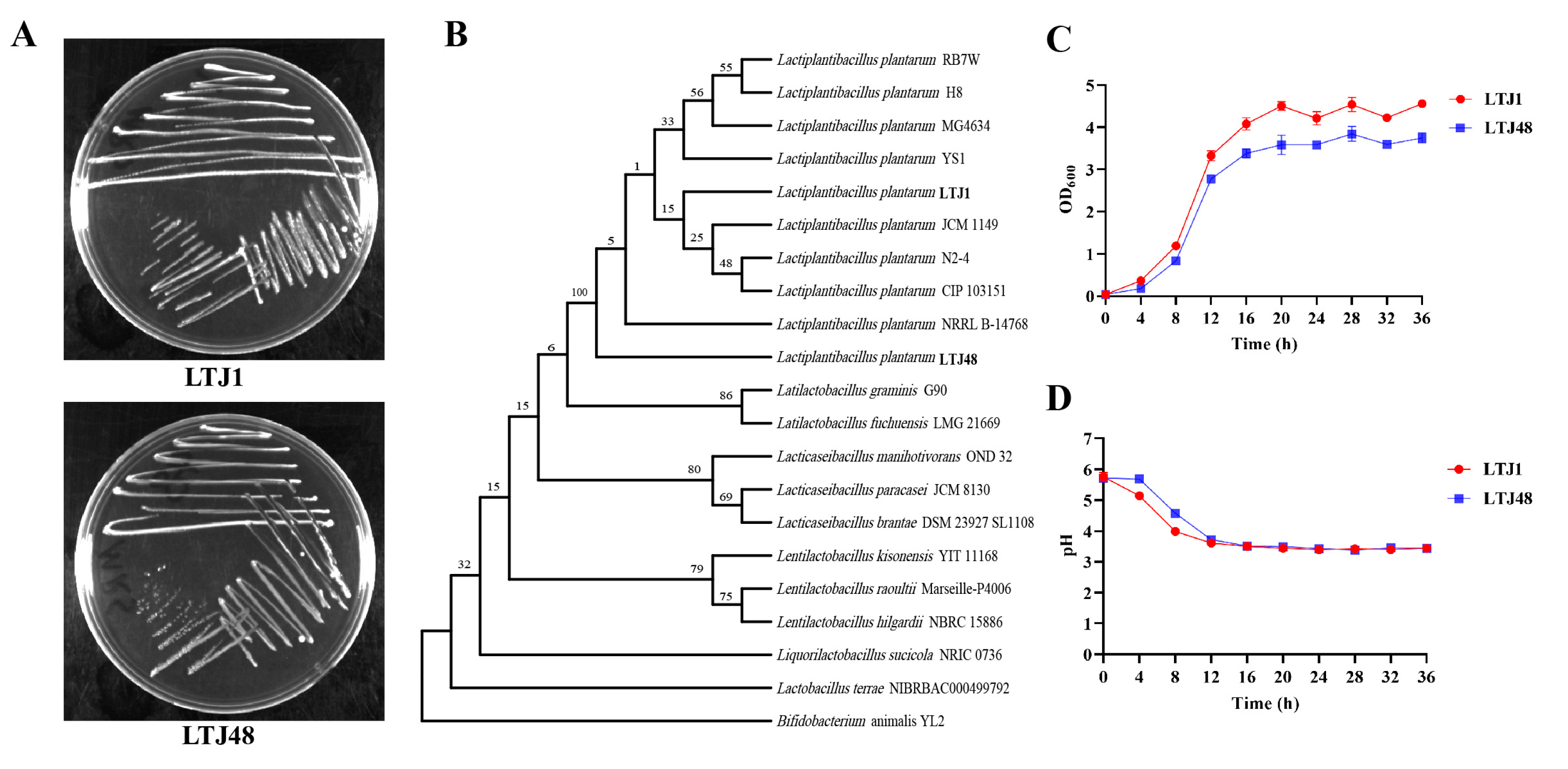
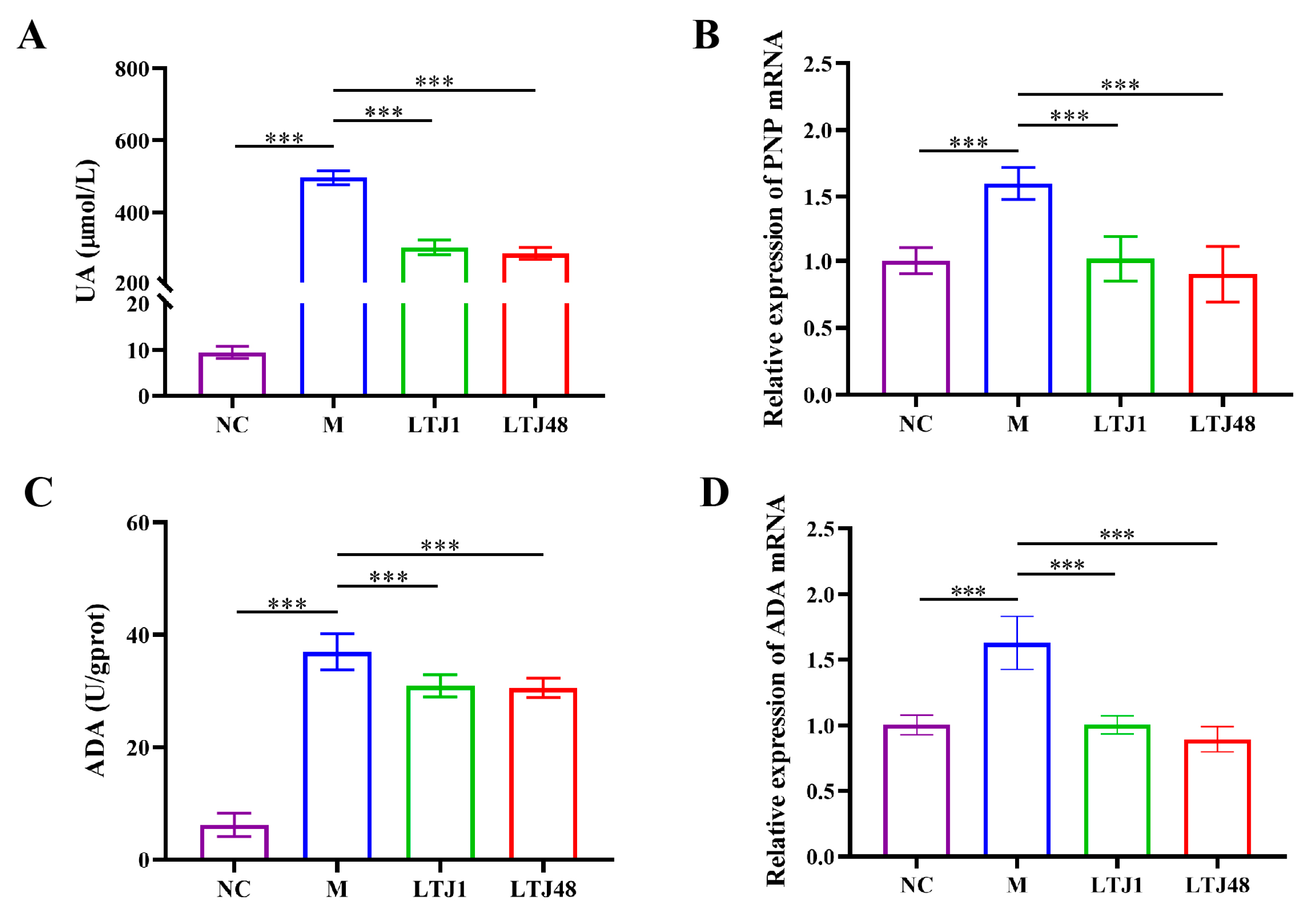
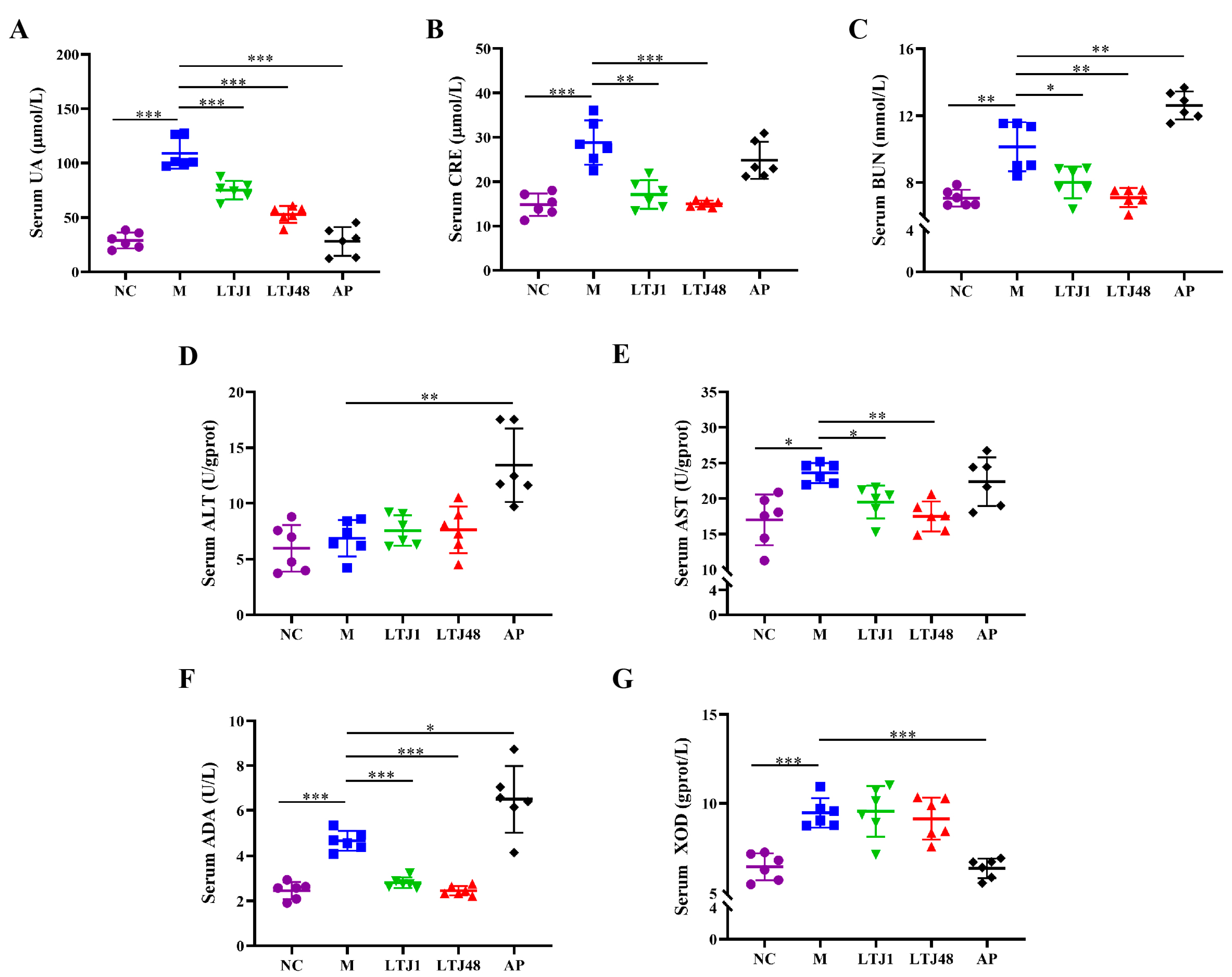
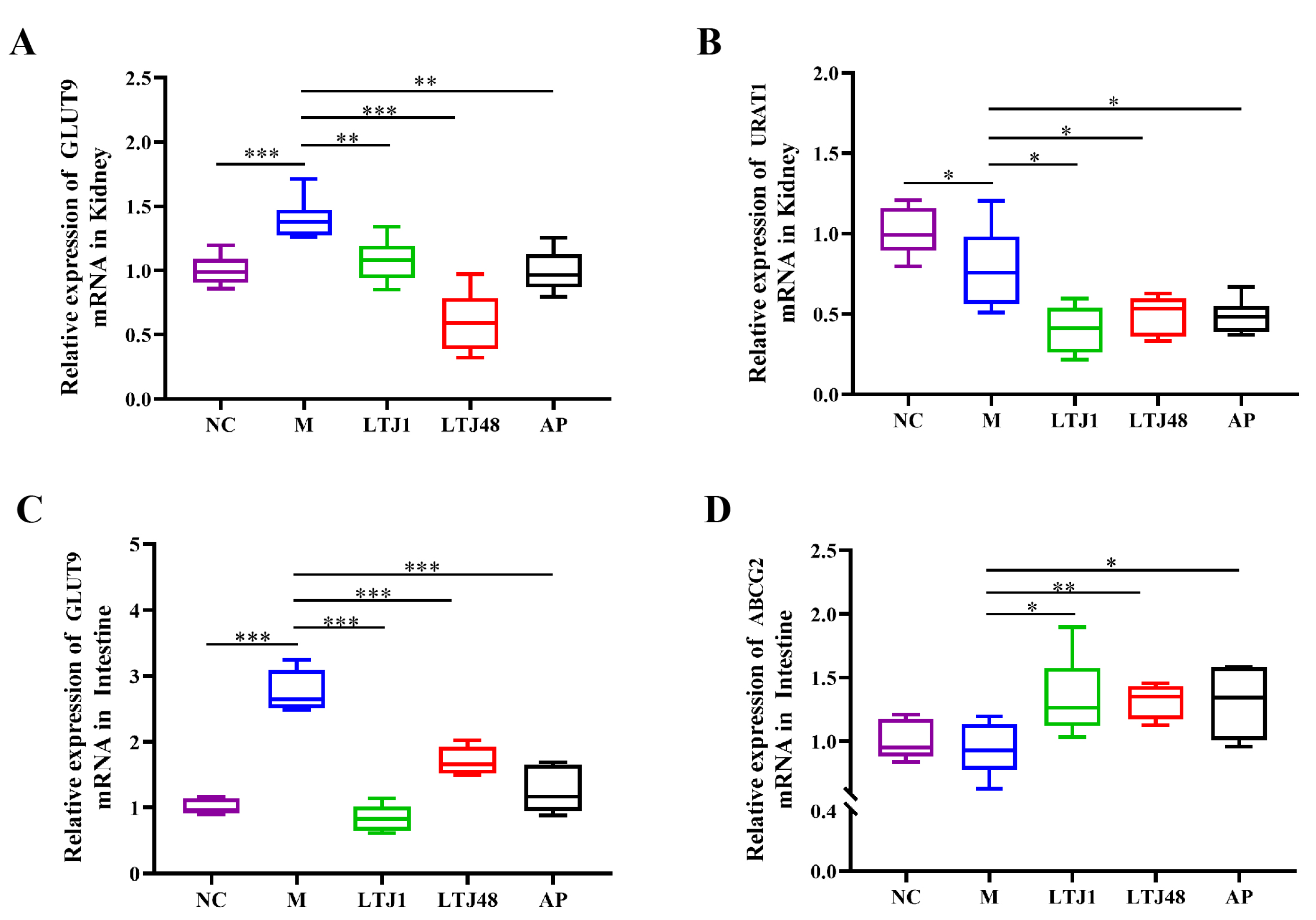
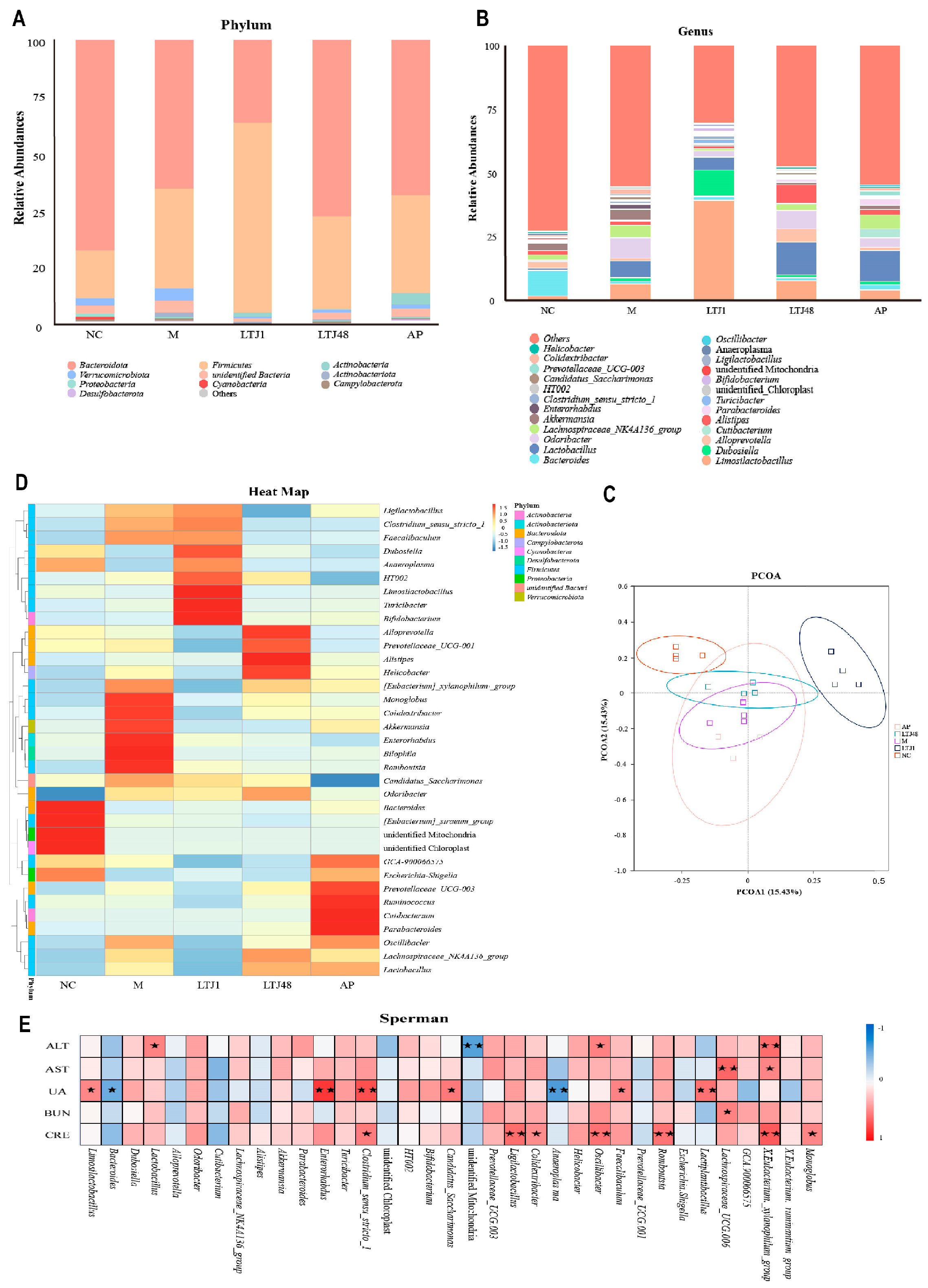
| Target Gene | Forward Primer | Reverse Primer |
|---|---|---|
| hADA | GCCTTCGACAAGCCCAAAGTA | CTCTGCTGTGTTAGCTGGGAG |
| hPNP | CTAAGCACCGACCTCAAGTTG | TGGGGATTTCACCGTAGTCAAAGA |
| hGAPDH | CTCCTGCACCACCAACTG | CAGTGATGGCATGGACTGTGGTC |
| mGLUT9 | GTGAAAAGAACTCCGCAGAAACCA | AGGAAGGAGGACCCGAAGGCTC |
| mABCG2 | ATGTCTTCCAGTAATGACCACGTGTTAG | GATGAAAACTCAACACATCTCCTTC |
| mURAT1 | TCCTGAACTCCTGGACCGAGTG | AGTTCTCCAGCATGTTCTGA |
| mGAPDH | ATGGTGAAGGTCGGTGTGAACGG | TGGAACATGTAGACCATGTAGTTGAGG |
Disclaimer/Publisher’s Note: The statements, opinions and data contained in all publications are solely those of the individual author(s) and contributor(s) and not of MDPI and/or the editor(s). MDPI and/or the editor(s) disclaim responsibility for any injury to people or property resulting from any ideas, methods, instructions or products referred to in the content. |
© 2025 by the authors. Licensee MDPI, Basel, Switzerland. This article is an open access article distributed under the terms and conditions of the Creative Commons Attribution (CC BY) license (https://creativecommons.org/licenses/by/4.0/).
Share and Cite
Zhong, F.; Feng, X.; Cao, J.; Li, M.; Tian, J.; Wang, J.; Wang, X.; Luo, X. Novel Potential Probiotics from Chinese Baijiu Fermentation Grains: Dual Action of Lactiplantibacillus plantarum LTJ1/LTJ48 in Uric Acid Reduction and Gut Microbiota Restoration for Hyperuricemia Therapy in Mice. Nutrients 2025, 17, 2097. https://doi.org/10.3390/nu17132097
Zhong F, Feng X, Cao J, Li M, Tian J, Wang J, Wang X, Luo X. Novel Potential Probiotics from Chinese Baijiu Fermentation Grains: Dual Action of Lactiplantibacillus plantarum LTJ1/LTJ48 in Uric Acid Reduction and Gut Microbiota Restoration for Hyperuricemia Therapy in Mice. Nutrients. 2025; 17(13):2097. https://doi.org/10.3390/nu17132097
Chicago/Turabian StyleZhong, Feiliang, Xiaomin Feng, Jun Cao, Miao Li, Jianxia Tian, Jiali Wang, Xuefang Wang, and Xuegang Luo. 2025. "Novel Potential Probiotics from Chinese Baijiu Fermentation Grains: Dual Action of Lactiplantibacillus plantarum LTJ1/LTJ48 in Uric Acid Reduction and Gut Microbiota Restoration for Hyperuricemia Therapy in Mice" Nutrients 17, no. 13: 2097. https://doi.org/10.3390/nu17132097
APA StyleZhong, F., Feng, X., Cao, J., Li, M., Tian, J., Wang, J., Wang, X., & Luo, X. (2025). Novel Potential Probiotics from Chinese Baijiu Fermentation Grains: Dual Action of Lactiplantibacillus plantarum LTJ1/LTJ48 in Uric Acid Reduction and Gut Microbiota Restoration for Hyperuricemia Therapy in Mice. Nutrients, 17(13), 2097. https://doi.org/10.3390/nu17132097






